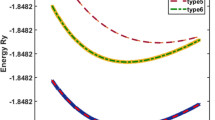Abstract
There are several approaches for the description of phase transitions (PT). leading to different classification schemes:
Approach | Classification scheme by |
|---|---|
thermodynamic | order (after Ehrenfest) |
kinetic | reversibility, quenchability, hysteresis |
structural | relationship of crystallographic axes before and after PT |
mechanistic | actual migration path of atoms during PT |
The most important techniques for investigating PT include DTA and DSC thermo-optical analysis, melastic neutron scattering, IR and Raman spectroscopy and elastic X-ray and neutron diffraction. The latter, as dependent on the temperature, can give indications on the mechanism of PT. The appropriate application of these techniques is demonstrated on the example of the polymorphism of KPO3.
Zusammenfassung
Phasenumwandlungen (PU) können unter verschiedenen Aspekten beschrieben werden, was zu unterschiedlichen Klassifikationen führt
Aspect | Klassifikation nach |
|---|---|
Thermodynamisch | Ordung (nach Ehrenfest) |
Kinetisch | Reversibilitä, Abschreckbarkeit, Hysterese |
Strukturell | Beziehungen kristallographischer Achsen vor und nach der PU |
Mechanistisch | Tatsächliche Bewegung der Atome während der PU |
Zu den wichtigsten Untersuchungsmethoden der PU zählen DTA und DSC, thermooptische Analyse, inelastische Neutronenstreuung sowie IR- und Ramanspektroskopie und elastische Röntgen- und Neutronenbeugung in Abhängigkeit von der Temperatur. Aus letzteren können Hinweise auf den Mechanismus der Umwandlungen erhalten werden. Die geeignete Anwendung der Methoden wird am Beispiel des Polymorphismus des KPO3 demonstriert.
Резуме
Существует нескольк о подходов к описанию фазовых переходов (ФП), приводящих к различным классифи кационным схемам. Так, при термодинамическом п одходе, фазовые перех оды, согласно Эренфесту, р азделяют по их роду. В кинетическом подход е классификация пров одится согласно их обратимо сти, способности к зак алке и наличию гистерезиса. При структурном подходе основным явл яется взаимосвязь кристаллографическ их осей до и после ФП, тогда как при механич еском — основным пара метром является действител ьный путь смещения атомов во время фазов ого перехода. Среди на иболее важных методов иссле дования ФП являются метод ДТА и ДСК, термоо птический анализ, жес ткое рассеяние нейтронов, ИК спектроскопия и спектроскопия комб инационного рассеян ия, а также диффракция нейтроно в и мягкого рентгеновского излу чения. Метод диффракц ии нейтронов, будучи зав исим от температуры, м ожет дать информацию о мех анизме ФП. Применение всех этих методов показано на п римере полиморфизма КРО3.
Similar content being viewed by others
References
F. Liebau. Fortschr. Mineral., 61 (1983) 29.
P. Ehrenfest, Proc. Kon. Amsterdam Acad., 36 Suppl. 75 b, 153 (1933)
M. J. Buerger, Fortschr. Mineral., 39 (1961) 39.
M. J. Buerger, Trans. Amer. Crystallogr. Assoc., 7 (1971) 1.
W. Schmahl, Dissertation. Mathem.-Naturw. Fakultaet, Universitaet Kiel, B.R.D. (1987)
K. H. Jost, Acta Crystallogr., 16 (1963) 623.
K. H. Jost and H. J. Schulze, Acta Crystallogr., B25, (1969) 1110.
K. H. Jost and H. J. Shulze. Acta Crystallogr., B27, (1971) 1345.
Author information
Authors and Affiliations
Additional information
I thank Dr. W. Schmahl for his enthusiasm and thoroughness during very enjoyable cooperative research effort.
Rights and permissions
About this article
Cite this article
Liebau, F. Phase transitions. Journal of Thermal Analysis 33, 107–111 (1988). https://doi.org/10.1007/BF01914589
Issue Date:
DOI: https://doi.org/10.1007/BF01914589




